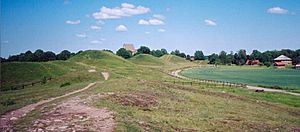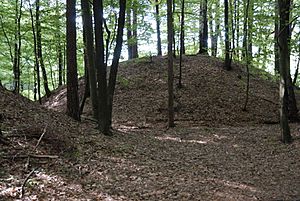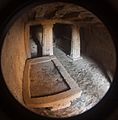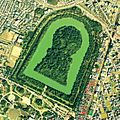Tumulus facts for kids

A tumulus (say "TOO-myoo-luss") is a special type of ancient grave. It's like a big mound of earth or stones built over a burial. The word "tumulus" comes from Latin. People used to bury their dead this way a very long time ago, during the Stone Age, Bronze Age, and Iron Age.
Contents
What is a Tumulus?
A tumulus is basically a large pile of earth or rocks that covers a grave or multiple graves. Think of it as an ancient monument for someone important who passed away. Sometimes, people call them burial mounds or barrows.
How Were Tumuli Built?
The way tumuli were built could be different depending on the time and place.
- Inside the Mound: Sometimes, the body was placed in a special stone coffin called a sarcophagus. Other times, the ashes of the person were put into a pot called an urn, and then the urn was buried.
- Chambers: Some tumuli had just one burial spot, while others were much bigger and had several rooms or chambers inside for different burials.
- Special Locations: Often, these burial mounds were built in important places. You might even find large stone circles or other ancient structures nearby, showing that the area was sacred.
Where Can We Find Tumuli?
Tumuli can be found all over the world, showing that many different ancient cultures used this way of burying their dead.
- Europe: You can see famous tumuli in places like Sweden, Denmark, and the United Kingdom. The Royal Mounds of Gamla Uppsala in Sweden are a great example from the 5th and 6th centuries.
- Asia: In Japan, very large tumuli called Kofun were built for emperors and powerful leaders. The Daisen Kofun is one of the biggest tombs in the world!
- North America: Native American cultures also built impressive mounds, like the Serpent Mounds Park in Canada, which are shaped like animals.
Why Are Tumuli Important?
Tumuli are like time capsules! When archaeologists study them, they learn a lot about how ancient people lived, what they believed, and what tools they used. The items buried with the dead, like pottery, weapons, or jewelry, give us clues about their daily lives and customs. They help us understand the history of human civilization.
Images for kids
-
The Kasta tumulus near Amphipolis in Greece.
-
Soulton Long Barrow, an example of modern burial mounds.
-
A memorial for the Battle of Varna dedicated to Władysław III of Poland, built into an ancient Thracian tumulus.
-
Part of the burial ground at Sutton Hoo, Suffolk, England, famous for its Anglo-Saxon ship burial.
-
King Björn's barrow in Håga, Sweden.
-
The tumulus Tinghøjen in Denmark. Denmark has about 26,000 preserved tumuli!
-
The "Tomb of Midas" in Gordion, Turkey, from around 740 BC.
-
Serpent Mounds Park, near Peterborough, Ontario, Canada, named for its zig-zag serpent-shaped mounds.
-
Grave Creek Mound, in Moundsville, West Virginia, USA, built by the Adena culture.
See also
 In Spanish: Túmulo para niños
In Spanish: Túmulo para niños
























